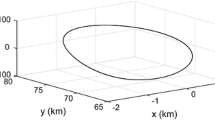Abstract
The constantly challenging requirements for orbit prediction have opened the need for better onboard propagation tools. Runge-Kutta (RK) integrators have been widely used for this purpose; however RK integrators are not symplectic, which means that RK integrators may lead to incorrect global behavior and degraded accuracy. Emanating from Deprit’s radial intermediary, obtained by the elimination of the parallax transformation, we present the development of symplectic integrators of different orders for spacecraft orbit propagation. Through a set of numerical simulations, it is shown that these integrators are more accurate and substantially faster than Runge-Kutta-based methods. Moreover, it is also shown that the proposed integrators are more accurate than analytic propagation algorithms based on Deprit’s radial intermediary solution, and even other previously-developed symplectic integrators.
Similar content being viewed by others
Change history
11 February 2022
A Correction to this paper has been published: https://doi.org/10.1007/s42064-022-0136-2
References
Ferrer, S., Lara, M. On roto-translatory motion: reductions and radial intermediaries. The Journal of the Astronautical Sciences, 2012, 59(1–2): 22–40.
Ferrer, S., Molero, F. J. Intermediaries for gravity-gradient attitude dynamics I. Action-angle variables. Second IAA Conference on Dynamics and Control of Space Systems, 2014.
Cid, R., Lahulla, J. F. Perturbaciones de corto periodo en el movimento de un satelite artificial, en funcion de las variables de Hill. Publicaciones de la Revista de la Academia de Ciencias de Zaragoza, 1969, 24: 159–165.
Gurfil, P., Seidelmann, P. K. Celestial mechanics and astrodynamics: theory and practice. Springer–Verlag, 2016.
Deprit, A. The elimination of the parallax in satellite theory. Celestial Mechanics, 1981, 24(2): 111–153.
Gurfil, P., Lara, M. Satellite onboard orbit propagation using Deprit’s radial intermediary. Celestial Mechanics and Dynamical Astronomy, 2014, 120(2): 217–232.
Lara, M. LEO intermediary propagation as a feasible alternative to Brouwer’s gravity solution. Advances in Space Research, 2015, 56(3): 367–376.
Blanes, S., Casas, F. A concise introduction to geometric numerical integration. CRC Press, 2016.
Hairer, E., Lubich, C., Wanner, G. Geometric numerical integration: algorithms for ordinary differential equations, 2nd ed. Springer, 2006.
Feng, K., Qin, M. Z. Symplectic geometric algorithms for Hamiltonian systems. Springer, 2010.
Simo, J. C., Tarnow, N., Wong, K. K. Exact energy-momentum conserving algorithms and symplectic schemes for nonlinear dynamics. Computer Methods in Applied Mechanics and Engineering, 1992, 100(1): 63–116.
Yoshida, H. Construction of higher order symplectic integrators. Physics Letters A, 1990, 150(5–7): 262–268.
Blanes, S., Casas, F., Farrés, A., Laskar, J., Makazaga, J., Murua, A. New families of symplectic splitting methods for numerical integration in dynamical astronomy. Applied Numerical Mathematics, 2013, 68: 58–72.
Farres, A., Laskar, J., Blanes S., Casas, F., Makazaga, J., Murua, A. High precision symplectic integrators for the Solar system. Celestial Mechanics and Dynamical Astronomy, 2013, 116(2): 141–174.
Tsuda, Y., Scheeres, D. J. Computation and applications of an orbital dynamics symplectic state transition matrix. Advances in the Astronautical Sciences, 2009, 134(4): 899–918.
Imre, E., Palmer, P. L. High-precision, symplectic numerical, relative orbit propagation. Journal of Guidance, Control, and Dynamics, 2007, 30(4): 965–973.
Palacios, L., Gurfil, P. Variational and symplectic integrators for satellite relative orbit propagation including drag. Celestial Mechanics and Dynamical Astronomy, 2018, 130(4): 31, DOI: 10.1007/s10569-018-9826-8.
Lara, M., Gurfil, P. Integrable approximation of J2-perturbed relative orbits. Celestial Mechanics and Dynamical Astronomy, 2012, 114(3): 229–254.
Schaub, H., Junkins, J. L. Analytical mechanics of space systems, 2nd ed. American Institute of Aeronautics and Astronautics, Inc., 2009.
Alfriend, K., Vadali, S. R., Gurfil, P., How, J., Breger, L. Spacecraft formation flying: dynamics, control and navigation. Butterworth–Heinemann, 2009.
Irigoyen, M., Simó, C. Non integrability of the J2 problem. Celestial Mechanics and Dynamical Astronomy, 1993, 55(3): 281–287.
Celletti, A., Negrini, P. Non-integrability of the problem of motion around an oblate planet. Celestial Mechanics and Dynamical Astronomy, 1995, 61(3): 253–260.
Hairer, E., Lubich, C., Wanner, G. Geometric numerical integration illustrated by the Stormer–Verlet method. Acta Numerica, 2003, 12: 399–450.
Suzuki, M. Fractal decomposition of exponential operators with applications to many-body theories and Monte Carlo simulations. Physics Letters A, 1990, 146(6): 319–323.
Hairer, E., Nrsett, S. P., Wanner, G. Solving ordinary differential equations I: nonstiff problems, 2nd ed. Springer–Verlag, 1993.
Acknowledgements
This work was supported by the European Commission Horizon 2020 Program in the framework of the Sensor Swarm Sensor Network Project under grant agreement 687351.
Author information
Authors and Affiliations
Corresponding author
Additional information
Leonel M. Palacios is a postdoctoral research associate at the High Contrast Imaging Laboratory of Princeton University. He received his Ph.D. degree in aerospace engineering from the University of Glasgow, the United Kingdom, in 2016. In May 2016, he joined the Asher Space Research Institute of the Technion-Israel Institute of Technology as a postdoctoral fellow working for the Satellite Swarm Sensor Network (S3NET), a project aimed for the development of the full potential of “swarms” of satellites through the optimized and enhanced use of their on-board resources. His areas of expertise include astrodynamics and dynamics and control of distributed space systems.
Pini Gurfil is a full professor of aerospace engineering at the Technion-Israel Institute of Technology, and director of the Asher Space Research Institute. He received his Ph.D. in aerospace engineering from the Technion in March 2000. From 2000 to 2003, he was with the Department of Mechanical and Aerospace Engineering, Princeton University. In September 2003, he joined the Faculty of Aerospace Engineering at the Technion. Dr. Gurfil is the founder and director of the Distributed Space Systems Laboratory, a research laboratory aimed at development and validation of spacecraft formation ying algorithms and technologies. He has been conducting research in astrodynamics, distributed space systems, and satellite dynamics and control.
Rights and permissions
About this article
Cite this article
Palacios, L., Gurfil, P. Symplectic orbit propagation based on Deprit’s radial intermediary. Astrodyn 2, 375–386 (2018). https://doi.org/10.1007/s42064-018-0033-x
Received:
Accepted:
Published:
Issue Date:
DOI: https://doi.org/10.1007/s42064-018-0033-x




